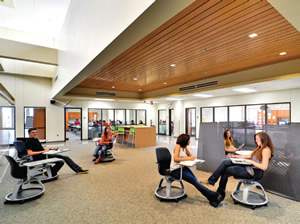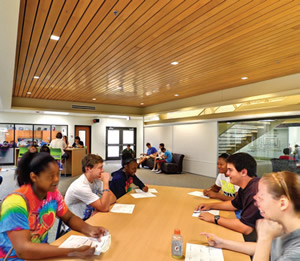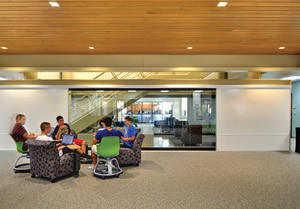Pleasing and Green
- By William Atkinson
- 03/01/14

PHOTOS BY LUIS AYALA, COURTESY OF SHW GROUP
What's new in school building products and materials, such as exterior cladding, doors, windows, roofs and hardware? These days, school districts expect more from products and materials than simply the ability to meet their basic requirements. More and more, school districts are looking for materials that are more energy efficient, more sustainable (especially as might apply to LEED projects), easier to install, more functional, more aesthetically pleasing, more reliable and durable and/or more cost-effective than in the past.
While all of these have been, are, and will continue to be important considerations in the selection of building products and materials, two of the most important considerations these days relate to energy efficiency and aesthetics.
Energy efficiency
“The biggest area of focus these days in terms of building materials and products relates to exterior cladding and openings,” says Dennis Hacker, AIA, CCS, CCCA, LEED-AP, BD+C, specification writer/manager for Fanning Howey (www.fhai.com), an architecture, engineering and design firm, specializing in schools and related community buildings. “This is because of the focus on energy — trying to reduce the overall energy cost of every building. For example, we are seeing more and more products on the market with thermal breaks and higher R-value insulation, to try to ‘tighten up the envelope.’”
While Hacker and his colleagues aren’t specifically seeing many completely “new” building products and materials in this area, they are seeing quite a lot of improvements to existing products and materials. “Manufacturers are working to make improvements to existing products or materials that will improve energy efficiency,” he says.
For example, after Hurricane Katrina hit New Orleans in 2005, Fanning Howey professionals were looking for building products and materials related to building openings that would be resistant to hurricane-force winds. However, they found that, at the time, they could get materials that were either resistant to hurricane-force winds, or that could meet the energy code, but not both. “For example, the materials that were strong enough to resist hurricane-force winds weren’t thermally broken or isolated,” says Hacker. “These days, though, materials exist that can do both.”
Years ago, few overhead coiling doors could meet energy standards, because too much air was leaking around them. “Since that time, though, they have been remanufactured and re-gasketed in order to reduce air infiltration,” he says.
There are also many new high-performance glass units available that are designed to improve the R-value. “Some of these even have different fillings, including gel, between the panes of glass, in order to improve the R-value,” he says.
One tool that helps with ensuring energy efficiency in new schools is 3-D energy modeling. “With this, we can study different orientations and different size openings, and determine how they will impact the energy efficiency of a building,” says Hacker.
And, as manufacturers are working to make their building products and materials more energy efficient, they are also taking steps to focus on sustainability. “For example, because of LEED requirements, a lot of manufacturers are going back and looking at where their raw materials are coming from, and taking other steps to comply with new LEED requirements,” says Hacker.
One agency with a strong commitment to energy management is the New Mexico Public School Facilities Authority (Albuquerque, N.M.) “I strongly believe that ‘product over provider’ is key to successful public owner projects,” says Robert A. Gorrell, director.
And the emphasis on products continues to grow for the NMPSFA. “For many years, we focused on enhanced mechanical systems with superior controls as a way to reduce energy and operational costs,” he says. “In doing so, though, we found that we had eventually worked ourselves into a corner.” The reason was that these efforts were not sustainable in terms of being able to continue on with them. That is, the Authority found that the skill sets of the people within the schools who were tasked with operating these systems were not adequate to support the ever-increasing sophistication of the mechanical systems.
In addition, reducing energy consumption that requires vigilant behaviors doesn’t always guarantee consistency. “For example, energy reduction can result when people turn down the temperature, turn out lights, close the doors, etc.,” says Gorrell. However, these behaviors are ones that cannot be depended on a regular basis.
As a result, these days, the Authority is focusing very strongly on energy management strategies that can be controlled — primarily the exterior shells of buildings. “In order to work on a shell, you have to work with multiple consultants as part of the project,” he says. “That is, making sure that we don’t have thermal conductance is something that requires close oversight of detailing, and close quality control of that detailing.”

Learning Together. Schools should be open, collaborative and nurturing environments where students feel comfortable sharing ideas; they should be adaptable for changing academic needs. A successful design relies on engaging the people within the school community in a structured process. Students at Plano ISD’s McMillen High School, in Texas, share ideas in one of the school’s collaborative learning spaces.
In working on such projects, the Authority has found that it is very beneficial to engage in mock-ups of exterior shell assemblies, including the glazing, the exterior finish, the framing, the roofing, the flashing on the roofing, etc. “In this way, if we are missing something, we can catch it early in the process,” says Gorrell. “At very least, it allows all of the various material suppliers, contractors and trades to understand what is going to be acceptable and what is not going to be acceptable. This decreases the dollars and the time that might be lost as a result of discovering problems after you are well on your way on a building project.”
Aesthetics
For a number of years, according to Fanning Howey’s Hacker, primarily because of the weak economy, owners often tried to solve the problem of not having much money to spend on new buildings by allowing design to take a back seat. “However, these days, owners want a little bit more,” he says. “They want to explore some different options, such as adding a little bit more ‘glitz’ or color in certain places. They don’t just want the bare bones, bottom dollar designs anymore.”
Vandana Nayak, AIA, LEED-AP, BD&C, project director and partner for SHW Group (www.shwgroup.com), an architecture, engineering and planning firm that specializes in educational facilities, agrees with the increased emphasis on the importance of aesthetics. However, she cites an additional reason for the new emphasis.
“K-12 schools look considerably different today than they did 15 to 20 years ago, reflecting the space requirements related to the discussion around 21st century learning systems,” she says. “The changes in exterior and interior material choices are reflecting the desire to create this new type of learning space.”
As a result, according to Nayak, the focus is not on being “rigid,” along the lines of, “Let’s build this to last 100 years.” “Today, it’s all about choices and flexibility,” she says. To achieve this requires different aesthetics, both on the outside and the inside.

Small Group Session. McMillen High School was designed by SHW Group with lots of glass, warm interiors, collaborative/flexible spaces and use of wood to create a welcoming environment that is conducive to relaxed group discussions. The availability of Wi-Fi also allows the students to work with their laptops or other personal devices.
Outside: “In the past, a lot of buildings looked very brutal, with a lot of exposed concrete,” she says. These days, however, schools want to appear more aesthetically inviting. One reason is that parents and students often have choices about which schools to attend. “Masonry is still used in the exterior, but there is more interest in having masonry of various dimensions, pallettes, textures and sizes,” says Nayak. “For example, there is an interest in a ‘finished composition,’ such as fiber cement boards.”
Inside: On the inside, just as on the outside, schools certainly want the basic structures to be able to remain for a long time. However, they want the interior spaces to be very flexible — with a focus on user configurability. “For example, instead of having rigid classrooms, there is a lot more interest in allowing classrooms to become larger and smaller as needs change, through the use of folding partitions,” says Nayak. There is also more interest in writeable surfaces, such as vinyl covering materials, so students can collaborate and learn anywhere in the school.
Perspective
Certainly, as noted in the introduction, there are a lot of considerations when selecting building materials and products, such as energy conservation, sustainability, aesthetics, ease of installation, durability and cost. However, as noted, these days, energy conservation and aesthetics seem to be “front and center.”
High-Performance Building Products Database for Public Use
In 2009, the Collaborative for High Performance Schools (CHPS) created a tool to help identify building products that contribute to sustainable, healthy, built environments. The tool is an online, searchable database where users, such as architects, building owners and contractors can search for products that have met certain environmental or health standards ranging from recycled content to materials that contribute to improved indoor air quality.
The project was funded by a grant from the US Environmental Protection Agency (EPA), and was supported by the California Integrated Waste Management Board (CIWMB), California Department of Public Health (CDPH) and the Carpet and Rug Institute (CRI).
The database lists low VOC (volatile organic compounds) emitting materials, materials containing recycled content, rapidly renewable materials, organically grown materials, certified sustainable wood products, and products with low mercury content. Product types range from construction materials to paints and carpeting.
The database can be found at www.chpsregistry.com.
This article originally appeared in the issue of .